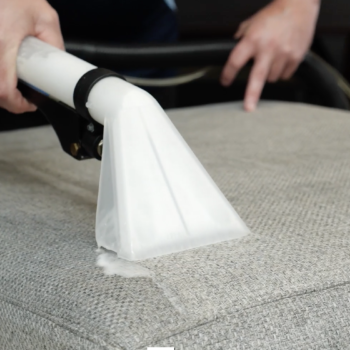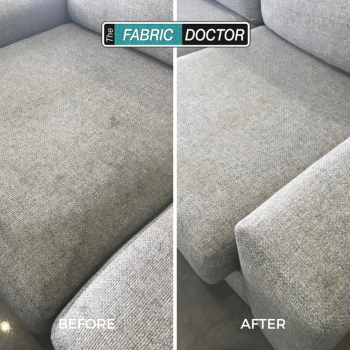Quick Fixes for Fabric Upholstery: Easy Tips to Repair Minor Damage at Home
Upholstered furniture in houses or commercial spaces experiences a lot of wear and tear.
Even if you’re careful with how its used, accidents, from a spilled glass of wine to muddy paw prints that require upholstery fabric cleaning and fabric upholstery repair are just a part of life. The best way to prevent stains on your fabric furniture, including sofas, chairs, benches and ottomans, isn’t to ban food and pets altogether—you just need to know what to do when stains happen.
If you work fast when a spill occurs, undertake regular upholstery fabric cleaning and upkeep your fabric upholstery protector application, you can handle spills, stains, and other mishaps with ease.
Whether you’re tackling a tough stain or removing unsightly pet hair, these cleaning tips will help keep your furniture looking pristine for years to come, avoiding potentially expensive fabric upholstery repair requirements.
Fabric Upholstery Repair – Mending Small Tears and Snags
In the unfortunate case where your fabric upholstery has been damaged, requiring fabric upholstery repairs, there are a few options you can attempt yourself, before seeking professional assistance.
In cases where there are loose threads but no visible tears, the best approach is to push the loose threads into the fabric, so they’re hidden on the back.
To treat situations where clawing creates holes, consider using a fabric glue. If the hole is alongside a seam, spread a thin layer of glue on the seam allowance (the part of the fabric that will be hidden once the seam is closed), and press the seam closed with your fingers for a few minutes. If the seam allowance is frayed, first coat it with a bit of seam sealant, which will basically glue the threads to each other and make them stiffer, so it’s easier to glue the seam back together.
Big holes in the middle of a section of upholstery need to be patched with fabric. If you don’t have leftover fabric and if your sofa is set against a wall, you might be able to salvage patch material from the back, perhaps from the skirt if your sofa has that type of upholstery.
Take care when attempting to undertake fabric upholstery repairs yourself. If not undertaken properly, the damage can spread and worsen. For professional fabric upholstery repairs advice or to have the work undertaken by a professional, contact your local Fabric Doctor.
Upholstery Fabric Cleaning – Removing Stains and Refreshing Faded Fabric
The sooner you undertake upholstery fabric cleaning when there is a stain or spill, the better your chances are of removing it. If you catch it right away, you might be able to get away with simply blotting the stain with a microfiber cloth. If water is safe to use on your upholstery fabric, there are many DIY upholstery fabric cleaning tactics you can try. To reduce the risk of spreading a stain when undertaking upholstery fabric cleaning, vacuum fabric before attempting stain removal, and always test first in an inconspicuous spot. If you’re met with a stain that just won’t budge, or seems to worsen when you address it, contact your local Fabric Doctor who are experts in upholstery fabric cleaning, stain removal and fabric upholstery repairs.
If your furniture doesn’t come pre-treated with a fabric upholstery protector, apply one yourself (or have a Fabric Doctor do it for you). If your fabric furniture is already treated with a fabric upholstery protector, ensure you understand how long it will last and know when it needs reapplication. Many of the treatments on the market must be reapplied every 6 to 12 months to retain their stain-fighting powers. Keeping up to date with your upholstery fabric cleaning routine and fabric upholstery protector application is key to keeping your fabric furniture looking great.
Fabric Upholstery Repairs – Handling Wear and Tear
The best way to care for fabric furniture is to first take some time to understand the fabric that is being used. Using the right upholstery fabric cleaning and fabric upholstery protector products on the upholstery will help prevent damage and will keep it looking better, for longer.
- The content label of the furniture displays the resistance of dyes to cleaning agents. Ensure you follow the guidelines to best care for your fabric furniture.
- After reading the tips on how to look after your fabric furniture, and before undertaking fabric upholstery cleaning or fabric upholstery protector, perform a patch test on the couch. Observe the results for 24 hours before undertaking extensive fabric upholstery cleaning or fabric upholstery protect
- A stain on an upholstered furniture must be acted on quickly to avoid the stain penetrating. One of the tips for sofa cleaning at home is to act quickly. Start by blotting the stain with a damp cloth until it disappears. Once the stain is gone, the wet surface of the fabric must be dried using a clean cloth, being careful not to leave water marks or rings.
- To deep cleaning fabric, use a vacuum to clean the surface debris on the couch. Start from the corners and cover the front and back sides of the couch to complete the process.
For maintaining the new-like sheen of any upholstery, fabric upholstery cleaning must be undertaken regularly. This will help in preventing the accumulation of dirt particles on the surface of the fabric and beneath. For professional fabric upholstery cleaning or fabric upholstery protection application advice or to have the work undertaken by a professional, contact your local Fabric Doctor.
Tips for Proper Upholstery Fabric Cleaning and Fabric Upholstery Repair
There are a number of tips and tricks to keep in mind, in order to better care for and maintain your furniture, preventing it from needing extensive fabric upholstery repairs and upholstery fabric cleaning.
Don’t scrub upholstered furniture, even when you’re dealing with tough, set-in stains. Scrubbing could grind the stain further into the fibres or damage the fabric. It’s better to blot at stains. Use a soft, microfiber cloth for blotting, not a coarse fabric or a bristled brush. If the fibres are stiff after cleaning and drying, use a soft brush to loosen the material.
Many people believe that the more moisture you use when undertaking upholstery fabric cleaning, the better, but this is not always true.
If your furry friends like to cozy up on the couch with you, try these tips for cleaning:
– To remove pet hair, put on a pair of rubber gloves and run them over your furniture. The gloves create static that pulls the hair off to the edge of the piece, where you can easily vacuum it off.
– Other effective tools for removing fur from upholstery include furniture brushes and hand vacuums designed for pet hair.
In Conclusion
When you’re undertaking upholstery fabric cleaning or fabric upholstery protection, don’t forget to also wash your throw blankets and throw pillows. If you use a washing machine, it’s generally best to stick with the gentle cycle on cold. If the pillow covers are removable, throw them in the machine inside out. Be sure to dry pillows thoroughly, as inner dampness can lead to mould. If you’re not sure your pillows are washable, freshen them with a spritz of water spiked with your favourite essential oil.
If you work fast, undertake regular upholstery fabric cleaning and upkeep your fabric upholstery protector application, you can generally handle spills, stains, and other mishaps with ease.
Whether you’re tackling a tough stain or removing unsightly pet hair, these cleaning tips will help keep your furniture looking pristine for years to come, avoiding potentially expensive fabric upholstery repair requirements. However, if your fabric furniture is in need of professional cleaning, stain removal, protection or repairs, contact your local Fabric Doctor for a free quote.





